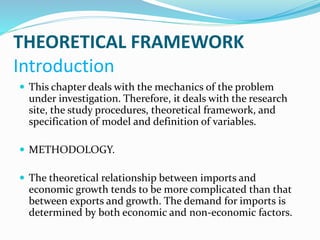presentation_updated
- 3. ÔÇó Amer Abbas ÔÇó Ghulam Abbas ÔÇó M.Adil Maqsood ÔÇó Kaleem Ullah ÔÇó Israr Ahmed
- 4. THEORETICAL FRAMEWORK Introduction ÔÇó This chapter deals with the mechanics of the problem under investigation. Therefore, it deals with the research site, the study procedures, theoretical framework, and specification of model and definition of variables. ÔÇó METHODOLOGY. ÔÇó The theoretical relationship between imports and economic growth tends to be more complicated than that between exports and growth. The demand for imports is determined by both economic and non-economic factors.
- 5. ÔÇó The purpose of this study is to provide an empirical test of the causal relationship between economic growth and imports, especially categories of imports, which are investment goods imports, raw material imports, consumption goods imports and other goods imports. ÔÇó The focus is Pakistan because recently Pakistan has lived an economic growth with a large current deficit. So, it is wondered if an economic growth causes an increase in imports or import expansion causes the economic growth.
- 6. ÔÇó This paper differs from the previous studies in that way; import is decomposed to determine the dynamic relationship between import categories and economic growth, comparing with the relationship between total import and economic growth.
- 7. Model specification  Y=F (L, K, X)  Y stands for GDP  L and K respectively stand for the input of labour and capital factors  X stands for the amount of imports and actually it is a variable added to original production function.  Labour force, capital and GDP is not a linear relation but an exponential relation, but it can be translated into linear relation by taking logarithm and a specific model of multiple linear regression is as follows:  Y= β0 + β1L + β2K + β3X +μ
- 8. HypothesesHypotheses # 1 ÔÇó H0: Reject ÔÇó HA: Accept ÔÇó H0: There is no significant relationship between GDP and Labour. ÔÇó HA: There is significant relationship between GDP and Labour. Hypotheses # 2 ÔÇó H0: Reject ÔÇó HA: Accept ÔÇó H0: There is no significant relationship between GDP and CAPITAL. ÔÇó HA: There is significant relationship between GDP and CAPITAL.
- 9. Hypotheses # 3 ÔÇó H0: Accept ÔÇó HA: Reject ÔÇó H0: There is significant relationship between GDP and IMPORTS. ÔÇó HA: There is no significant relationship between GDP and IMPORTS.
- 10. DEFINITION OF VARIABLES  GDP growth  The market value of final goods and services newly produced with in a nation’s boundaries during a fixed period of time. The GDP growth is the dependent variable because it has influence by the other variable.  Labour  The aggregate of all human physical and mental effort used in creation of services. Labor is a primary factor of production. The size of a nation'slabor force is determined by the size of its adult population, and the extent to which the adults are either working or are prepared to offer their labor for wages.
- 11. ÔÇó Capital ÔÇó Factors of production that are used to create goods or services and are not themselves in the process, like machines. ÔÇó Imports ÔÇó The term import is derived from the conceptual meaning as to bring in the goods and services into the port of a country, it include imports of the primary products like raw material.
- 12. DATA COLLECTION METHODS AND SOURCES ÔÇó Data for this study is collected from secondary sources like; books, report and internet. The data collected is given a proper setup with the help of applying research tools and procedures. ÔÇó To obtain secondary data the sources like web- site and publications of state bank of Pakistan, journals and website of ministry of finance, and federal bureau of statistics, library books and IFS etc.
- 13. Empirical evidence  Y=β0 + β1L + β2K + β3X +μ  Y= -25587.93+2049.112L-0.028932K+1.067639X  Interpretation  Dependent variable = GDP  Independent variable = CAPITAL, LABOUR AND IMPORTS  β0 = Intercept  β1= coefficient of labour.  β2= coefficient of capital.  β3= coefficient of imports.  Values of  β0 =-25587.93  β1= 2049.112  β2= -0.028932  β3= 1.067639
- 14. ÔÇó 1% increase in labour leads to 2049.112% increase in GDP; by taking other factors are constant, and we say that there is positive relationship between labour and GDP, And 1% increase in capital leads to -0.028932% decrease in GDP, we say that there is negative relationship between capital and GDP,And 1% increase in imports leads to 1.067639% increase in GDP,and there is positive relationship between imports and GDP
- 15. Ols estimation Dependent Variable: GDP Method: Least Squares Date: 05/28/12 Time: 08:55 Sample: 1980 2007 Included observations: 28 Variable Coefficient Std. Error t-Statistic Prob. C -25587.93 3152.315 -8.117186 0.0000 L 2049.112 109.2836 18.75040 0.0000 IMP 1.067639 0.364938 2.925539 0.0074 CAPITAL -0.028932 0.029335 -0.986238 0.3339 R-squared 0.989750 Mean dependent var 60045.18 Adjusted R-squared 0.988468 S.D. dependent var 21932.52 S.E. of regression 2355.234 Akaike info criterion 18.49823 Sum squared resid 1.33E+08 Schwarz criterion 18.68855 Log likelihood -254.9752 Hannan-Quinn criter. 18.55641 F-statistic 772.4609 Durbin-Watson stat 0.831716 Prob(F-statistic) 0.000000
- 16. CONCLUSIONS ÔÇó The aim of this study is to check the impact of imports on economic growth. In this study we find that there is positive relationship between economic growth and imports. One percent increase in the real GDP due to 1.69 % increase in imports. There is negative relationship between economic growths and capital to the imports, it means the capital is imports from the foreign countries the cash is outflow from domestic to foreigner. This means that there is negative relationship between the imports of capital and economic growth.
- 17. ÔÇó Finally the study conclude that the imports are the harmful for the domestic industries the reason is that increase the supply of goods the domestic consumption is shift and demand for the foreign goods are increase. But in a country the overall growth performance is increase.
- 18. REFERENCES


















